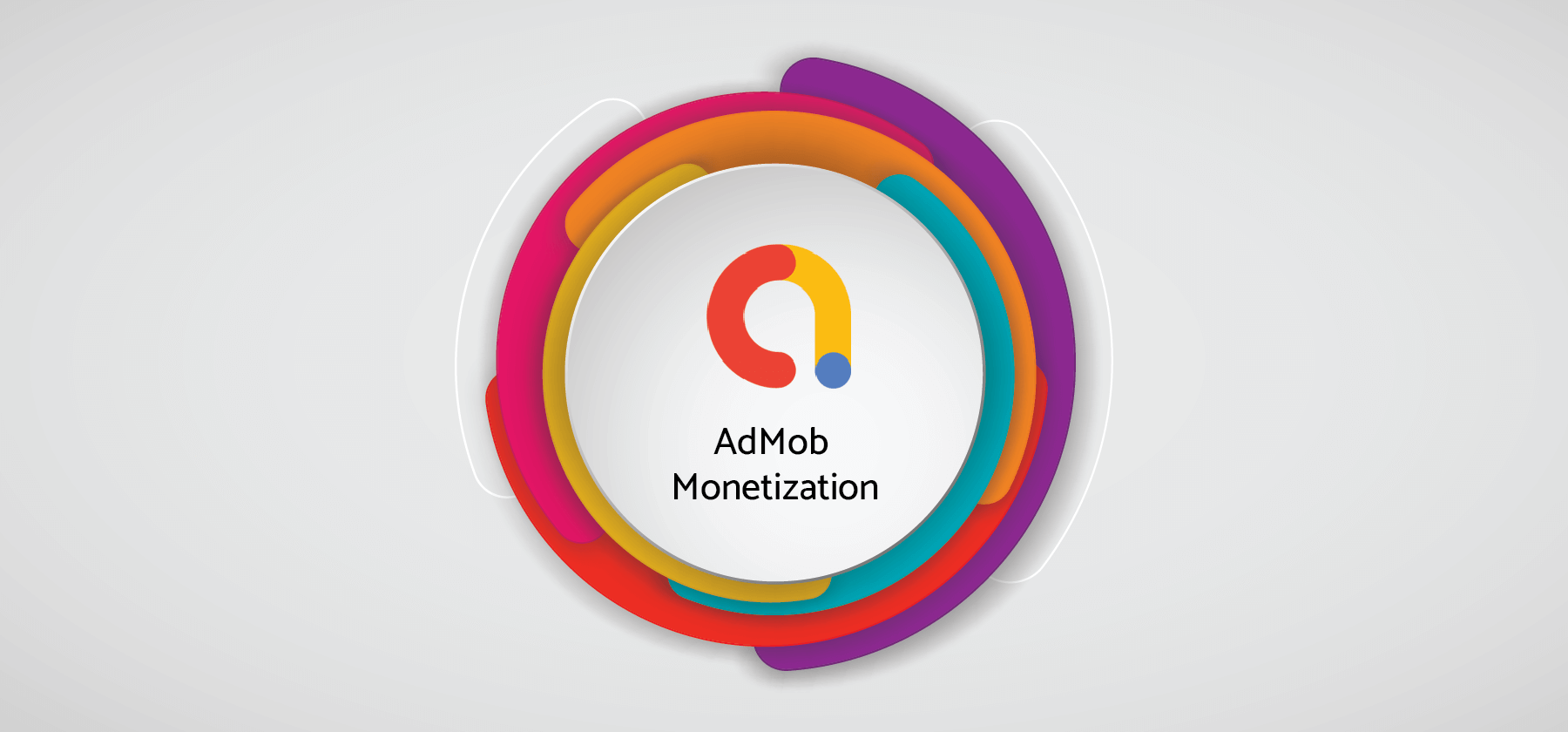- This blog post has provided an overview of Google DoubleClick for Publishers.
- It has explained the role of DFP in the ad serving process, the different types of ads that can be served on Google DFP, and how to get started with Google DFP.
The Google advertising ecosystem has come along a long journey of technological evolution over the years. From functioning as a simple auction system in 2000 to introducing useful features from time to time, such as site targeting, and demographic-specific display ads, Google ads have become a prevalent and indispensable digital advertising platform for businesses worldwide.
With constant improvements in Google’s online advertising system, the network has become more profitable for app advertisers and publishers looking to make money from mobile apps. That’s why Google launched Doubleclick for Publishers (DFP). While every app publisher on Google has a unique objective to achieve, app monetization always remains their top priority.
Small and medium publishers can use Google AdMob alternatives to monetize their apps easily. However, publishers with 5+ million views or DAU feel like AdMob is limiting their app’s monetization potential, not allowing them to monetize the traffic to the fullest.
So, what’s the solution to their problem? That’s where Google DoubleClick comes into the picture. DFP is a central place to monetize different types of inventory like mobile apps, games, and videos.
In this regard, our blog post examines the ins and outs of Google Doubleclick for publishers to discover how this feature drives value to the publishers. Before we get started, let’s look at Google’s brief history of rebranding to make its advertising ecosystem more accessible and value-driven.
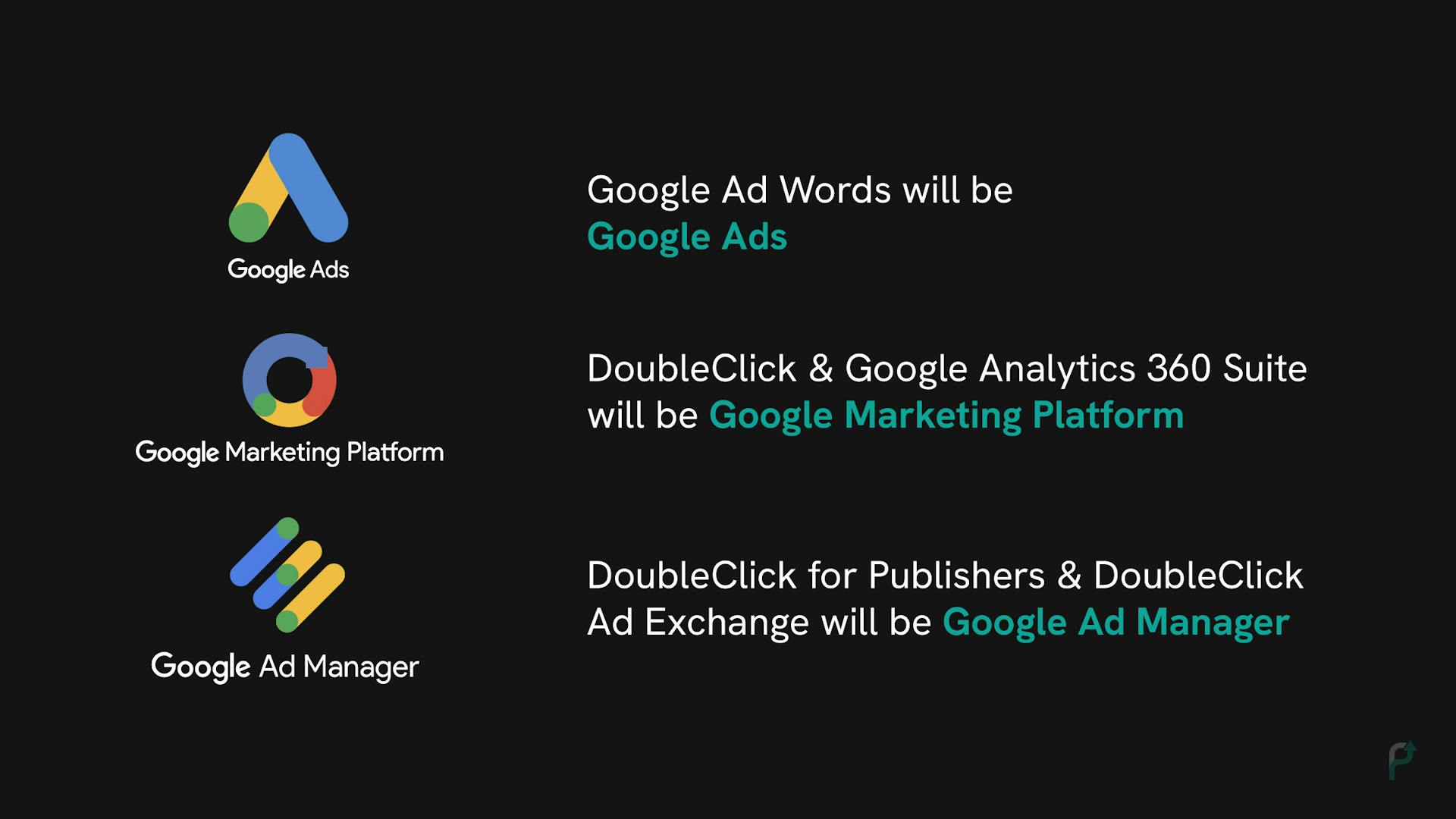 Rebranding of google programmatic platforms
Rebranding of google programmatic platformsWhat is Google DoubleClick for Publishers (DFP)
Google DoubleClick is a full-fledged ad-serving platform designed to streamline various processes associated with ad monetization on the publisher side.
Note that Google announced the rebranding of DFP as Google Ad Manager (GAM) on June 27, 2018, with combined core DoubleClick for Publishers and DoubleClick Ad Exchange (AdX). These two are Google’s former services that shut down once GAM was launched.
Although DoubleClick for Publishers is a powerful tool for publishers, many often misunderstand DFP as they think of it as an independent ad server or supply-side platform. However, DFP is an innovative programmatic advertising solution that is way more useful than any ad server or SSP.
Owned by Google, DoubleClick for publishers offers a seamless user experience and optimized features similar to your experience on Google’s top products like AdMob.
Publishers looking to increase their ad revenue from existing formats or planning to modify their entire ad publishing strategies can leverage the benefits of DFP and achieve sustainable ad revenue growth.
Maximize profits: Connect with PubScale for DFP integration.
Role of DFP in the ad-serving process
Let's understand the role of Google DoubleClick for Publishers in the whole ad-serving process. Simply put, we will understand the journey of ads from DFP to a particular app. Following is the explanation of the ad serving process in a nutshell:
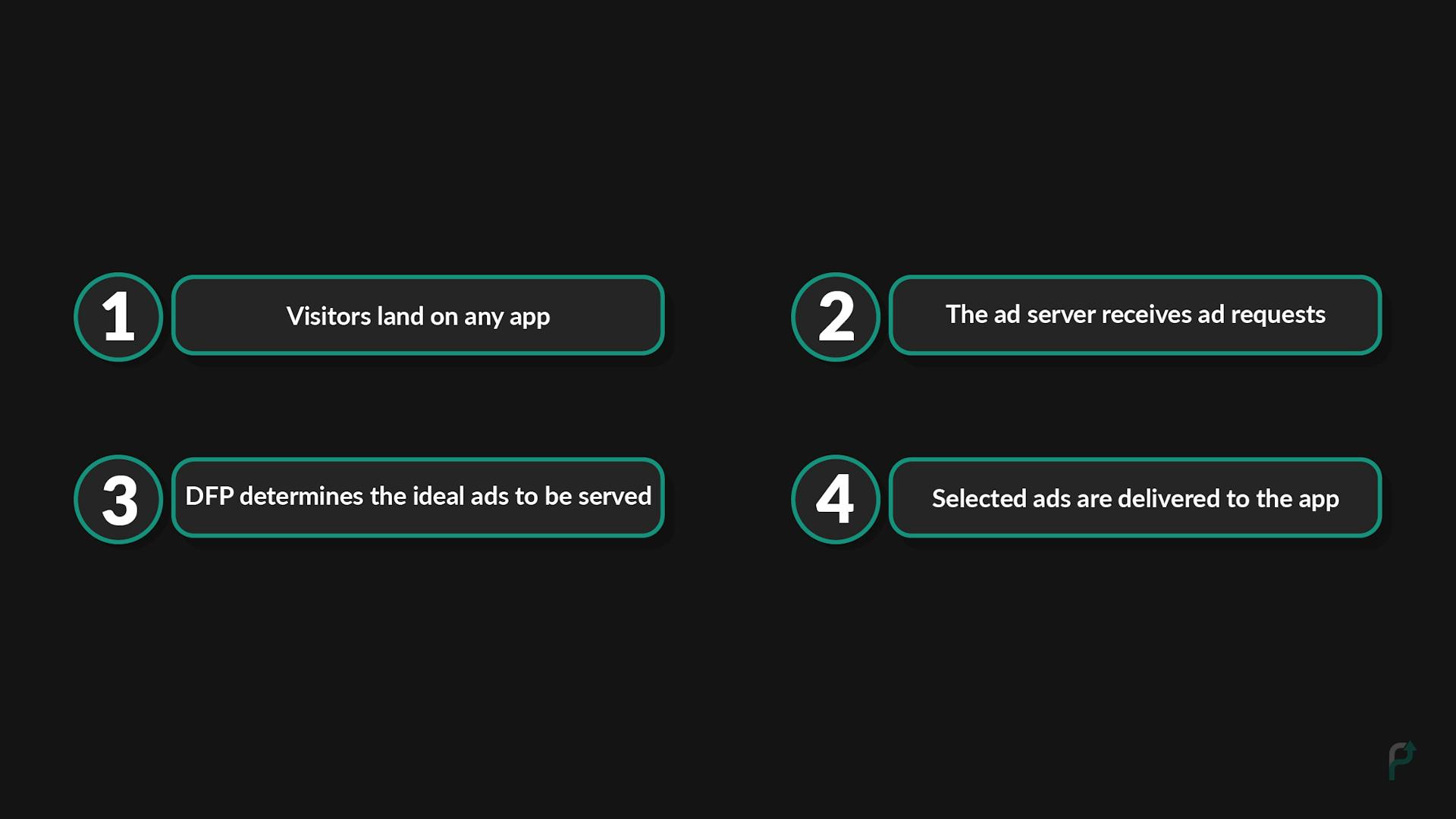 Role of DFP in ad-serving
Role of DFP in ad-serving- Visitors land on any app- As soon as a user opens an app, the ad content immediately gets loaded via the web server. That said, the ads must come from a server such as DFP.
- The ad server receives ad requests - Once the app spots any user, it sends some parameters to the DFP as to what ads will be suitable for the publisher's vacant slot on the app.
- DFP determines the ideal ads to be served - DFP strategically analyzes the parameters such as audience type, ad format, and slot size to serve high-performing ads on empty slots.
- Selected ads are delivered to the app - Upon successfully serving ads on the desired slots, DFP keeps track of the times a particular ad is served and how much traction it has gained, including clicks, impressions, conversion, etc.
How does DoubleClick for publishers work
Specify your ad inventory
Determining your ad inventory is similar to putting a vacant space on a physical hoarding or banner for sale. When done on DFP’s ecosystem, publishers need to specify ad inventory for an app or website to sell it to the advertisers.
Sell your ad inventory to advertisers
Interact with demand-side platforms or direct advertisers and tell them the total number of clicks and impressions your ad slots receive. Furthermore, review advertisers' campaign terms and agree to them if they are legit. This way, you reserve the right buyers for your ad inventory.
Setup your campaign
Now that you have ad inventory and advertisers, the next step is to set up advertisers' objective-specific campaigns using Google DoubleClick for publishers. These objectives include ad delivery, targeting options, geo locations, and custom audience targeting.
Optimize your ad revenue
Maximizing your ad revenue is all about grabbing the highest bid for your ad slots. If you cannot find your ideal advertiser with bidding and other approaches to selling ad slots, another tried and proven way to do it is by accessing an ad exchange.
For your ease, DoubleClick for publishers allows you to connect your ad exchange on the platform and get direct access to advertisers ready to pay the most for your ad inventory.
Deliver your ads
Once you upload creatives to DFP, your ads are set to deliver. Google's fast and reliable infrastructure guarantees that your campaign delivers creatives on time while achieving its desired goals.
Measure ad performance
As a publisher looking to earn the most from each impression on various ad slots, you must track and measure the ad performance as soon as your ads are live. Ad performance tracking is not challenging in the Google ads ecosystem, thanks to DFP's fast, flexible, and robust reporting features.
Additionally, DoubleClick for publishers supports regular optimization of campaign delivery and releasing new ad revenue opportunities.
Monetize games: Power up with DFP!
How to get started with Google DFP (now called GAM)
Google makes it mandatory for publishers to have a valid AdSense account if they want to access and use Google Ad Manager (DoubleClick for Publishers). Follow the below steps if you have an AdSense account. Or else, you can create an account first and then get started with the following steps:
-
Visit Google Ad Manager’s home page and click “Get Started”.
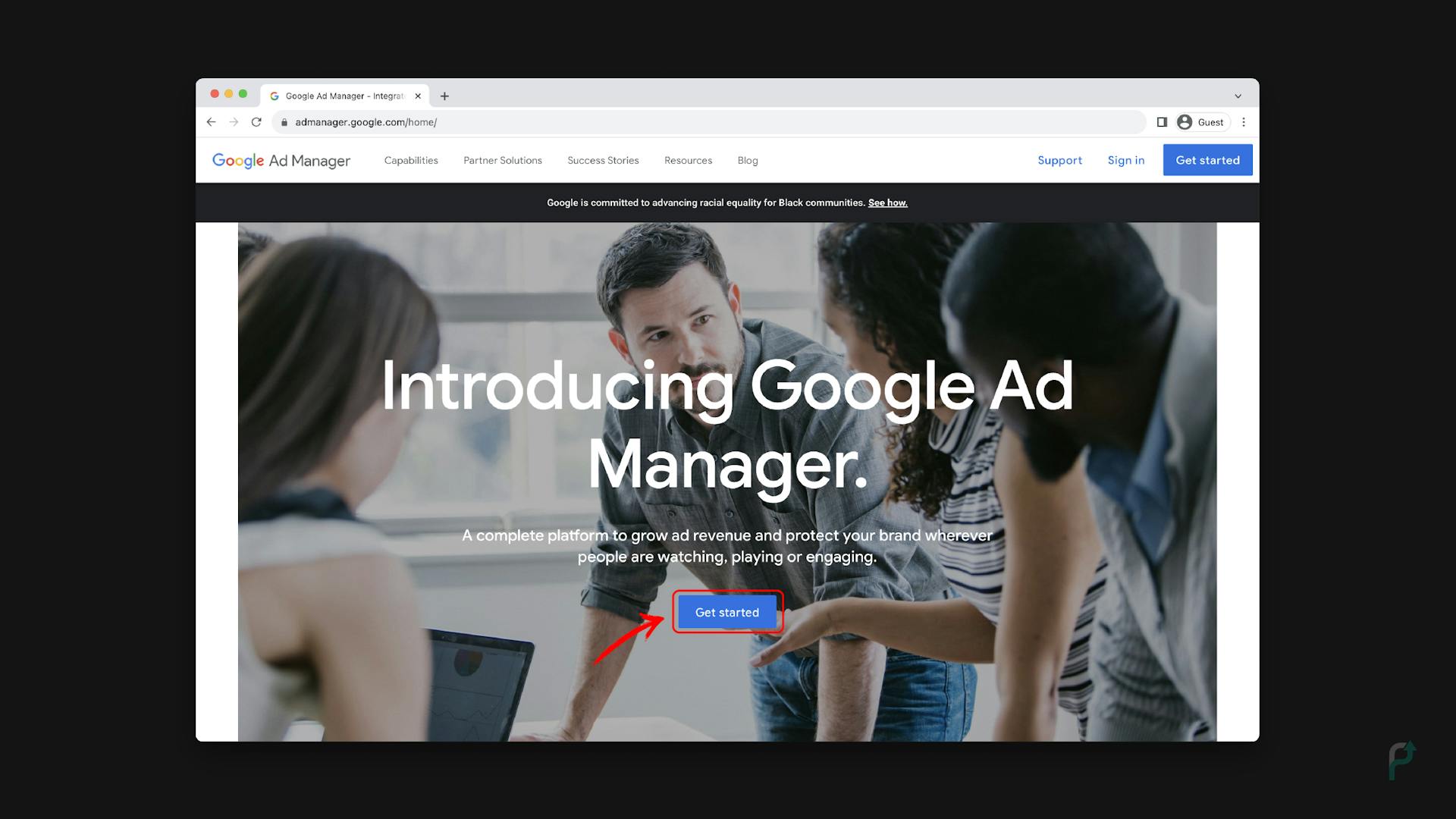 Google ad manager sign-up screen
Google ad manager sign-up screen -
Provide Google with an idea about your business niche. Choose a best-fit option from the suggestion (see the box in the below image) and click on “Continue”.
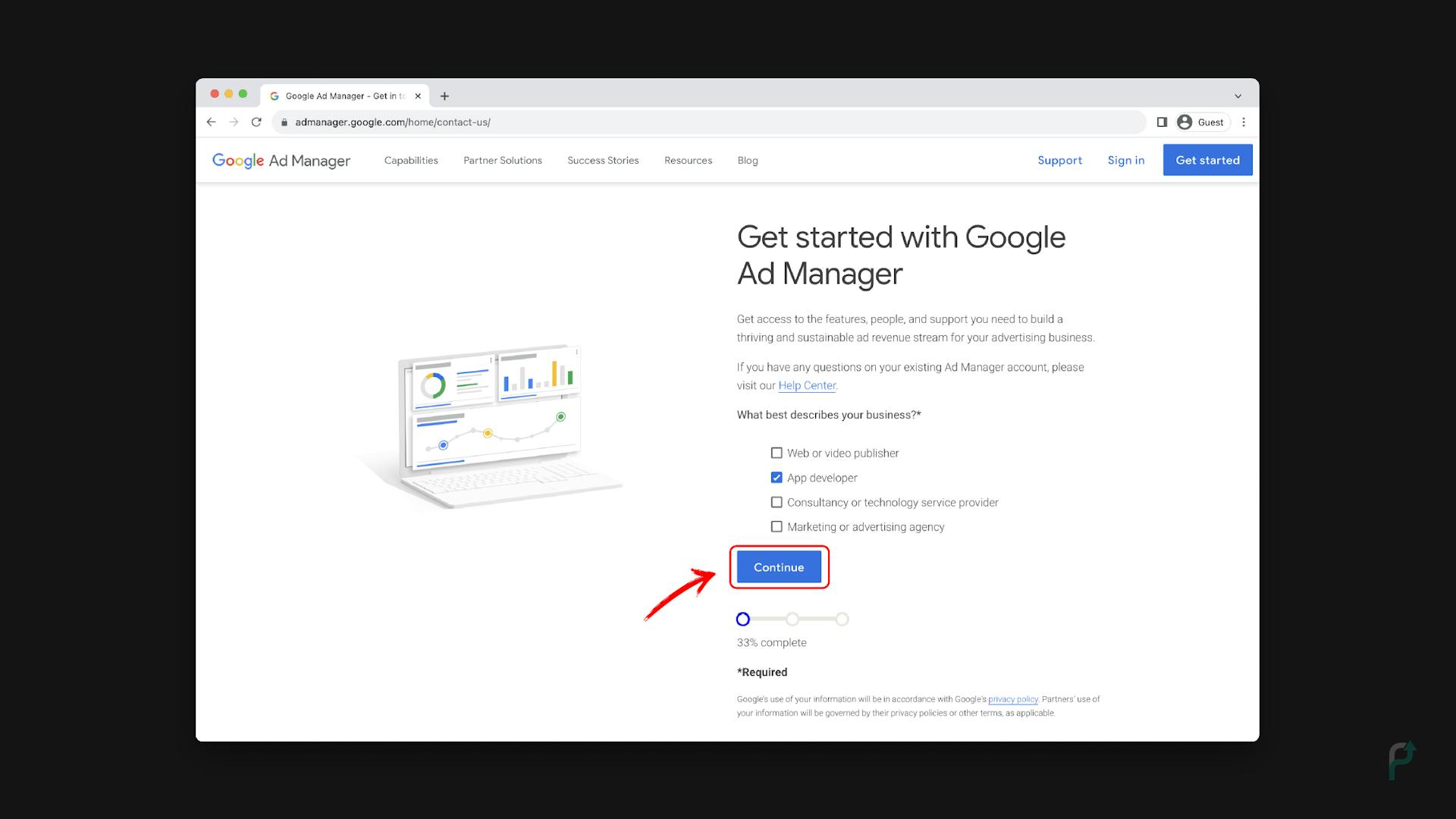 GAM onboarding business niche
GAM onboarding business niche -
Fill in more details about your app business, from the number of daily active users, your preferred features, your Google Adsense account details, and the region where your business is based.
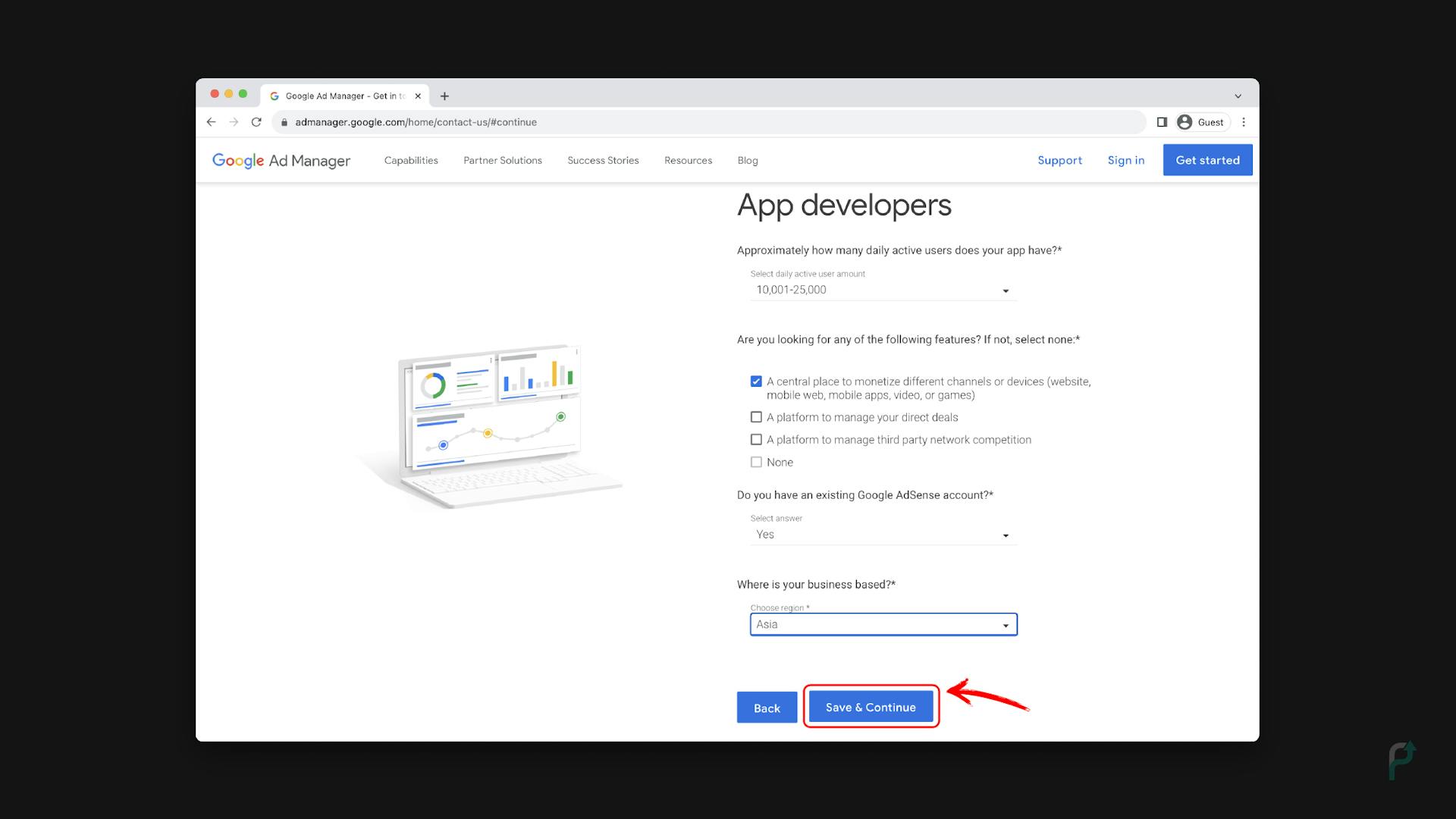 GAM onboarding business details
GAM onboarding business details -
On the next step, Google Ad Manager will ask you to fill in a form with details like your name, company’s name, website address, country, and a brief description of your campaign objective. Once you complete the form, click on “Submit”.
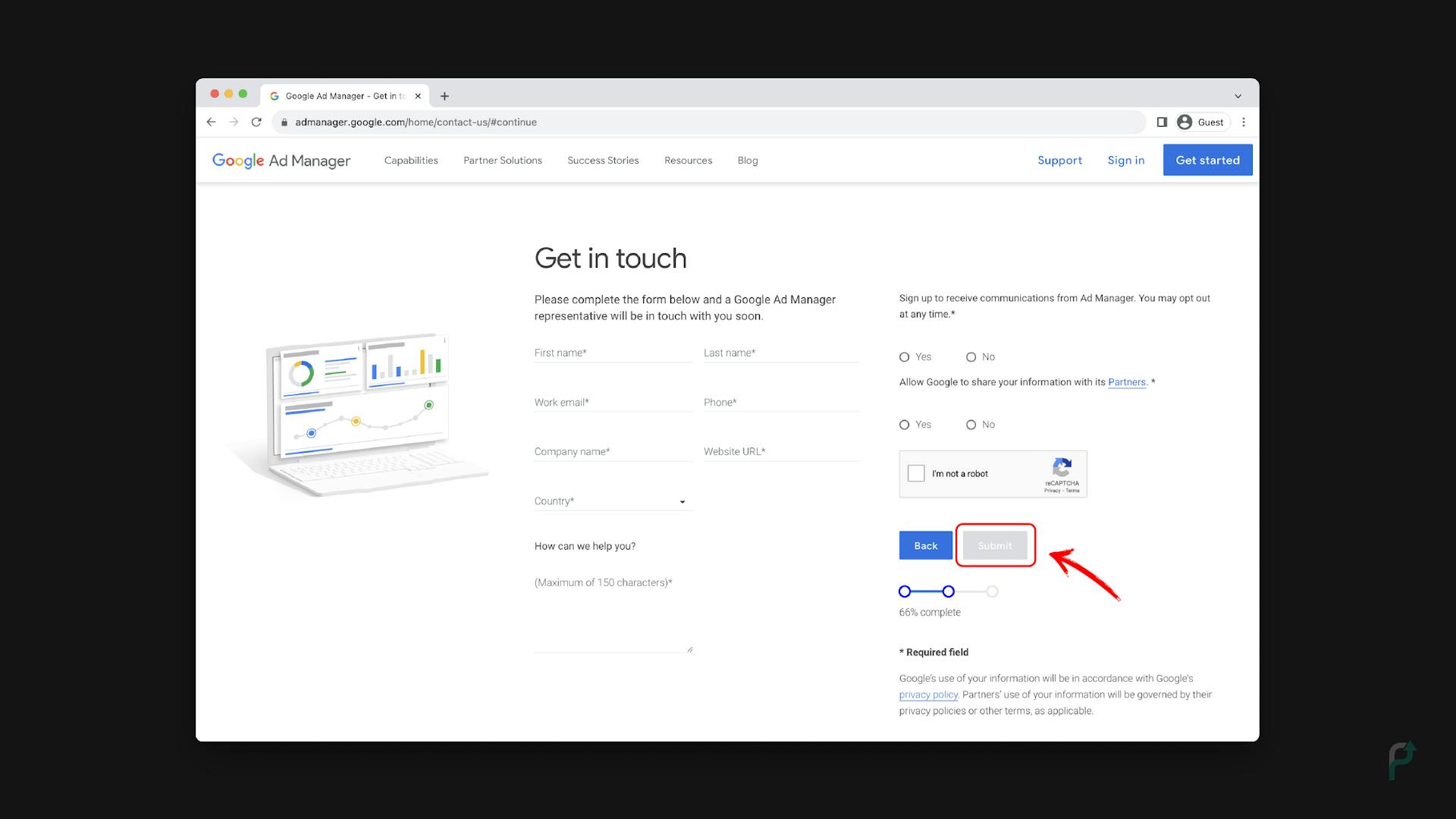 GAM onboarding campaign details
GAM onboarding campaign details -
Google Ad Manager does not immediately approve your request to access GAM. Their team reviews your application thoroughly and gets back to you with the final decision.
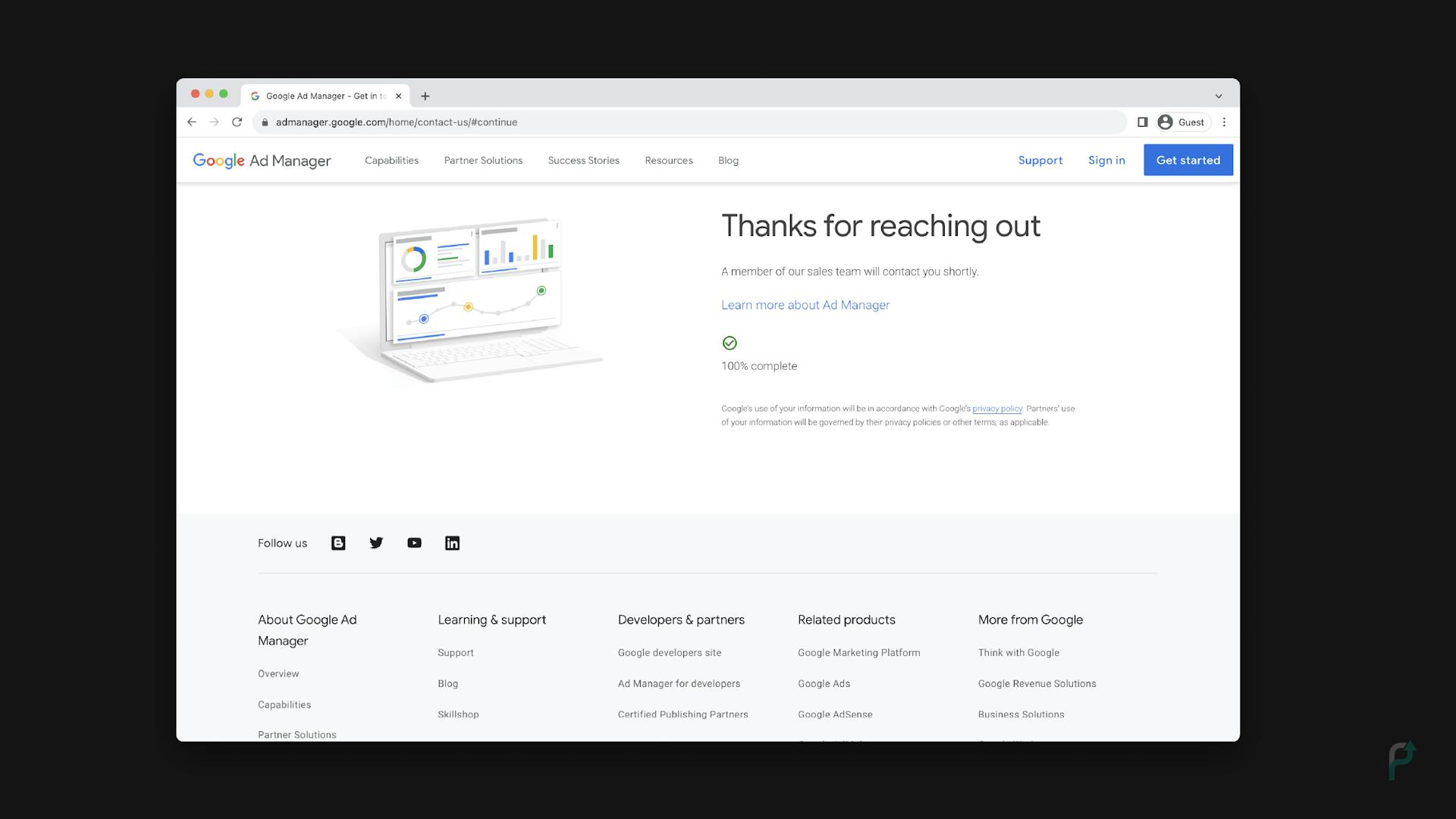 GAM onboarding thank you page
GAM onboarding thank you page -
If your application is approved, Google will allow you to sign up for Google Ad Manager and continue to maximize your ad revenue.
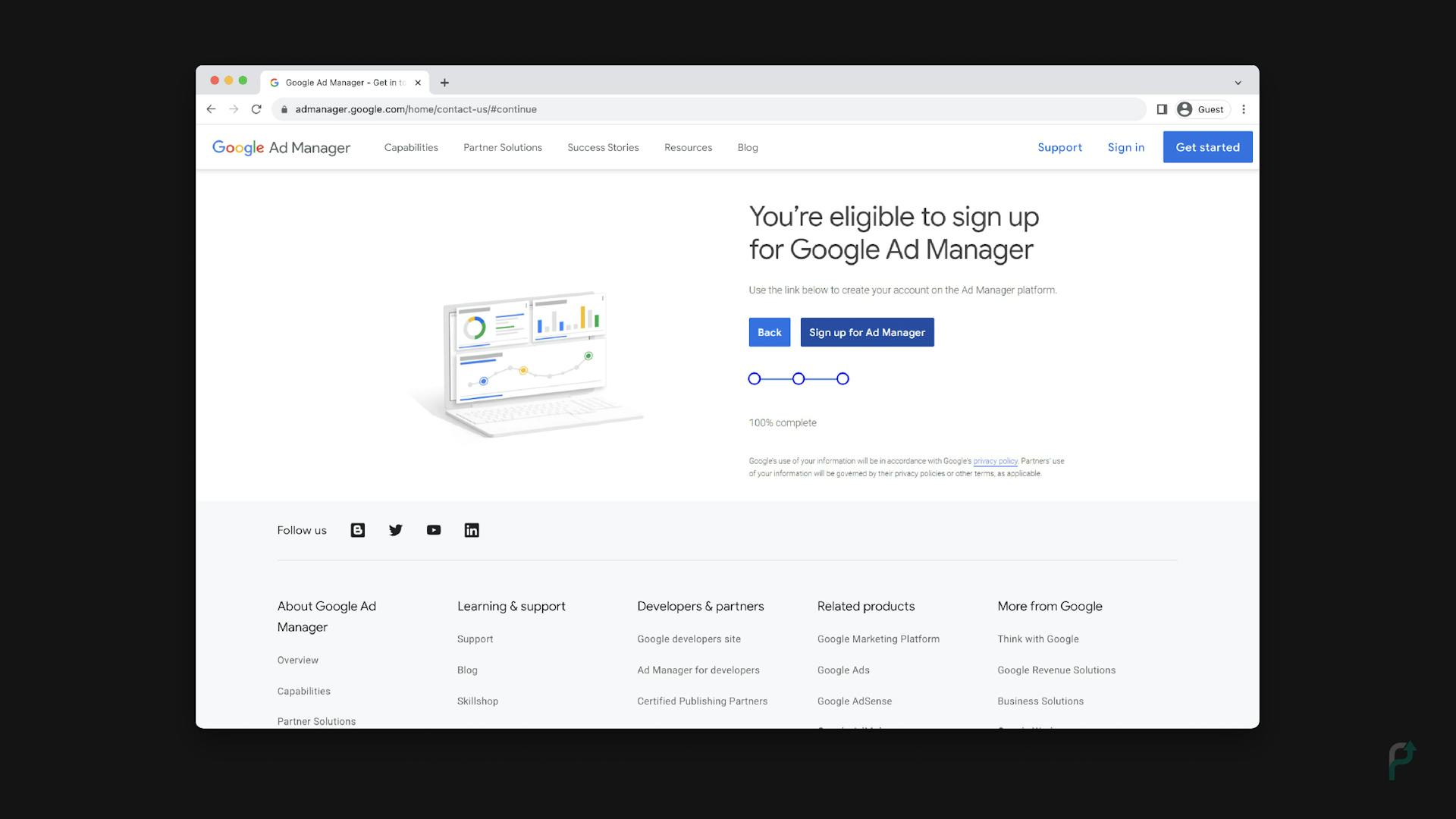 GAM onboarding confirmation
GAM onboarding confirmation
How is it better than Ad Servers
Google DoubleClick for publishers distinguishes itself from other ad servers with its unique and unparalleled Google AdX dynamic allocation setup. A dynamic allocation is an automated approach to determining whether Google ad exchange ads or third-party ads should run or not on the Google ecosystem.
With DFP, publishers get an idea about their potential revenue from AdX. Also, they remain assured about maximum earnings from ads since DFP only chooses to run the AdX ads with the high-paying bid.
AdX ads that fail to pick high bids don’t generally qualify for DFP. Instead, DFP prefers to run ads from third-party ad inventory that pays more. This concept signifies that DoubleClick for Publishers is better than ad exchange or any ad server as it ensures high revenue for publishers.
GAM vs. AdX vs. Adsense- A comparison
| Aspect | Google DFP- Now called GAM | Google AdSense | Google AdX |
|---|---|---|---|
| What is it | Rebranded as Google Ad Manager, DoubleClick for publishers acts as a compact programmatic advertising solution that publishers can use for ad delivery, publishing, monetization, and more. | Self-managed website monetization platform designed for small and medium-sized publishers. Publishers can put their inventories across millions of advertisers for real-time bidding. | Earlier known as Double click exchange, Google AdX is a real-time ad inventory marketplace that allows advertisers and publishers with a unified platform to bid, buy, and sell ad inventory. |
| Payment model | Publishers are free to choose a payment model, CPM or CPC. | CPC- Cost per click | CPM- Cost per impression |
| Participation criteria | Publishers must have 5M+ monthly page views or daily active users. | No threshold applicable | 10M monthly page views or daily active users required |
| Setup and use | Can be complicated for newbie publishers. | Easy to setup and use | Complicated because Google set complex guidelines to grant access to AdX. |
| Suitable for | Established publishers | New to semi-established publishers. | Highly established publishers. |
| Free or paid? | Both free and paid versions are available as GAM and GAM 360, respectively. | Free to use | Free to access |
| Technical proficiency | Partially substantial, you may require a Google-approved advertising partner | Not required | Highly substantial. Collaborate with a Google-approved advertising partner |
Are you struggling with DFP integration?
DoubleClick for Publishers Glossary
-
Ad inventory
Ad space available on a publisher’s app for sale. For example, if an app has 50 ad units and 30 are open for bidding, 30 are considered ad inventory.
-
Ad units
Slots or space on an app/website that occupies ads for advertising purposes.
-
IAB
International Advertising Bureau who are authorized to define ad sizes globally to bring uniformity across publishers.
-
Order
Generally called a “campaign”, an order refers to an ad request that advertisers make for the publisher’s inventory.
-
Bidding
Bidding or real-time bidding in the advertising ecosystem refers to a process by which advertisers bid for publishers’ ad inventory and close the sales deal quickly in real-time.
-
Line item
Every ad order must have a minimum of one line item as it defines various parameters for the ads to run. For example, which ad unit will the ads utilize, which format and creative to use, and what details to enable effective custom targeting.
-
Ad creative
Content that will appear on the desired ad units. Ad creatives can be still images, videos, blogs, or banners per brand parameters.
-
Audience targeting
An audience-limiting approach to define the right audience demographic for the ads and limit its display to people who are more likely to engage, retain, and convert.
-
Ad placement
Grouping of multiple ad units in a technically organized manner.
-
Forecasting
DoubleClick for publishers aggressively monitors and measures your app/site’s traffic and impressions on the existing ad units to predict the future availability of ad inventory.
-
Dynamic allocation
A publisher-centric feature that allows third-party line items to compete with AdX and AdSense ad inventory, guaranteeing high bids for your ad inventory.
-
Dayparting
An approach that divides a day into various parts to define specific running time for the publishers.
-
Frequency capping
Features for allocating rules regarding how often the ad will be displayed to the same audience.
-
Fallback
A backup creative that supports the on-time display of creatives to the desired ad slot in case users’ browser faces some technical faults or inefficiencies in seeing the primary creatives.
-
Guaranteed and Non-guaranteed
Line items that guarantee to deliver a specific amount of impressions. On the flip side, Non-guaranteed line items are not obligated to provide specific impressions as these only fill the leftover inventory.
-
Exclusion label
Labels that are assigned to line items to separate it’s served separately across the line items with the same levels.
-
Publisher Console
A valuable tool for solving tagging issues and debugging ad delivery.
Google DoubleClick for Publishers FAQs
-
What is DFP?
DFP, called DoubleClick for publishers, is a Google-owned ad management solution that allows publishers to manage everything around their ad inventory, including sell, deliver, and schedule.
-
Why was DFP rebranded to GAM?
GAM is the hybrid version of DoubleClick for Publishers since it was formed by merging Google Double Click Ad Exchange and Google DoubleClick for publishers. Hence, publishers do not need to sign up and manage two different platforms after Google Ad Manager (GAM).
-
Do I need Adsense to account for using DFP?
Not necessarily. Serving ads on your app through DFP does not require an Adsense account. However, you need to connect your AdSense account to DFP to gain access to it.
-
What benefits will I get by connecting my Adsense and AdX accounts to DFP?
Google Ad Manager is integrated with innovative features and capabilities. When you connect your Google AdSense or Google AdX to GAM, it automatically gets a record of your unsold inventory and fills it back to avoid wastage.
-
Is Google DFP free or paid?
Google DoubleClick for Publishers is now GAM, with two versions: Google Ad Manager (GAM), free version and Google Ad Manager 360 (GAM 360), paid version.
-
What are the terms & policies associated with DFP?
Google allocates strict policies and a set of rules to ensure high safety on GAM. See this blog to understand DoubleClick for Publishers (GAM) related rules clearly.
Although the criteria for monthly impressions are negotiable with Google, a publisher’s app or website must have over 5 million impressions to get started with a Google Ad Manager account. If you meet this criterion, Visit Google Ad Manager and follow the instructions to get started.
The only ad platform built for developers by developers.
Contact us now for a product that fits your needs! It’s quick, simple and easy.



